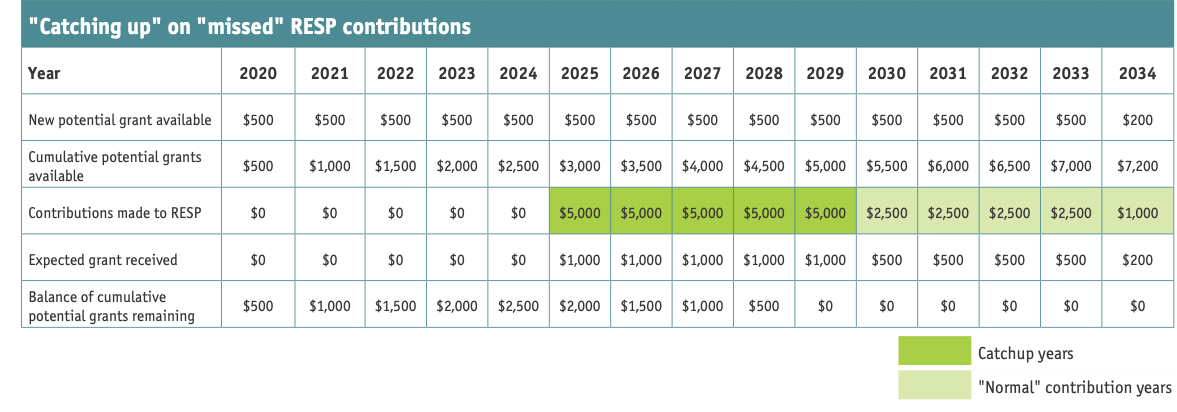Growing Your Family: RESP Funding
If there’s a new child or grandchild in your family, as a Canadian MoneySaver reader, you’re likely already thinking about how to save for their future education. Many Canadians are familiar with the Registered Education Savings Plan (RESP), but there are a few key opportunities you might be missing out on that could make a big impact.
RESP Foundations
RESPs are a great tool for funding future education costs. While RESP contributions don’t reduce your tax bill like Registered Retirement Savings Plan (RRSP) contributions do, they’re made with after-tax dollars—like how contributions are made to a Tax-Free Savings Account (TFSA). The money inside the account grows tax-sheltered, and if used for post-secondary education, income from the account is taxed in the student’s hands. Since many students have little or no income and have tuition tax credits, the result is often little to no tax—making RESPs an excellent income-splitting and tax-sheltering strategy.
Additionally, for contributions up to $2,500 per year into a RESP, the government offers “free money” through the Canada Education Savings Grant (CESG). You’ll receive 20% of the value of your contributions deposited into the account—up to $500 per year per child. The lifetime CESG maximum is $7,200, which means to fully take advantage, you’d need to contribute $36,000 over roughly 14.4 years.
You can open a RESP as soon as your child has a Social Insurance Number (SIN), and the first calendar year of birth counts towards CESG entitlement. RESP grants are available until the end of the year a child turns 17, and if you “miss” a year, you can catch up one extra year at a time—contributing an extra year’s worth ($5,000 total) to receive up to $1,000 in grants in one year.
For example, if your child was born in 2020 and you’ve never contributed, you could start now with $5,000 annually and continue until you’ve caught up on all missed grants. A table at the end of this article shows a catch-up schedule for a 2020 baby with no prior contributions.
Families with 1-3 children with a combined family income of $55,867 (at the time of this writing) may be entitled to the Canada Learning Bond (CLB) in addition to the CESG, and the income threshold increases if there are 4 or more children. The CLB provides a lifetime maximum of $2,000, and there are no contributions required to receive it. For more information about the CLB, refer to the “CLB amounts and eligibility criteria” at https://www.canada.ca/en/services/benefits/education/education-savings/estimating-amounts.html.
If you live in BC or Quebec, there are additional provincial grants:
- BC Training and Education Savings Grant (BCTESG): $1,200 one-time grant, no contribution required, available only when your child is age 6–8.
- Quebec Education Savings Incentive (QESI): An additional matching grant on RESP contributions.
Beyond The Basics:
Advanced RESP Strategies
Most families focus on maximizing the CESG with $2,500 annual contributions. But there are two points worth considering:
- 1. The lifetime RESP contribution limit per child is $50,000—$14,000 more than the amount needed to max out CESG.
- 2. There is no annual contribution limit—you can deposit the full $50,000 in year one if you wish. Contributions above $2,500 simply don’t receive grants (unless you’re catching up. In that case, contributions above $5,000 don’t receive grants).
What happens if you front-load the plan? The effect of compounding over 17+ years can be powerful.
Let’s look at three simplified scenarios, all assuming:
- A baby born in 2025.
- Contributions are made on January 1 each year, including this year.
- CESG deposited same day for simplicity.
- Growth compounds once annually at 5% at the beginning of each year.
- Contributions stop after 14 years (in 2039), and the account continues to grow for 3 more years. Note: for simplicity, this excludes the final $1,000 in contributions that would normally be made in year 15 to reach the full $36,000 required to maximize the CESG. That pesky final year has been left out to simplify the analysis.
Scenario 1:
Normal Contributions with CESG
- You contribute $2,500 per year for 14 years, receiving $500 in grants annually.
- Total out-of-pocket contributions: $35,000
- Projected value by age 17: ~$71,500
Scenario 2:
Normal Contributions + $14,000 Upfront
- In year one, you contribute $16,500 + receive a $500 grant (total year one inflow of $17,000), then continue contributing $2,500 annually and receiving $500 in grants for 13 more years.
- Total out-of-pocket contributions: $49,000
- Projected value by age 17: ~$103,500
Result: That initial $14,000 extra grows to an additional ~$32,000 thanks to compounding.
Scenario 3:
Superfund — Full $50,000 Upfront
- You contribute the full $49,000 + receive $500 CESG in year one and make no further deposits.
- Note, that you’d contribute $50,000, but to be fair in the assessment of potential benefits, we are maintaining consistency with scenarios 1 & 2.
- Total out-of-pocket contributions: $49,000
- Projected value by age 17: ~$113,500
Result: This scenario—surprisingly—outperforms the grant-maximizing strategy by about $10,000, assuming consistent 5% returns.
What’s The Best Strategy?
If investment returns are strong, “superfunding” the RESP early may outperform traditional annual contributions—even with fewer grants. That said, future returns are uncertain.
Families invested in portfolios of equities and/or fixed income may benefit most from this strategy. GIC investors won’t see the same lift, but even then, using the extra $14,000 early can still offer a meaningful boost.
I often tell clients: “A bird in the hand”—the guaranteed 20% CESG— “is worth two in the bush”—the potential for higher returns. But understanding all your options helps you choose what’s right for your family.

Hannah McVean is a Certified Financial Planner with Objective Financial Partners, a fee-only, advice-only financial planning firm in Canada. She works with clients from all walks of life and from all over the country, providing objective, unbiased financial advice. Hannah specializes in tax planning to improve cash flow and ensuring a seamless integration between the financial plan and the tax return.

